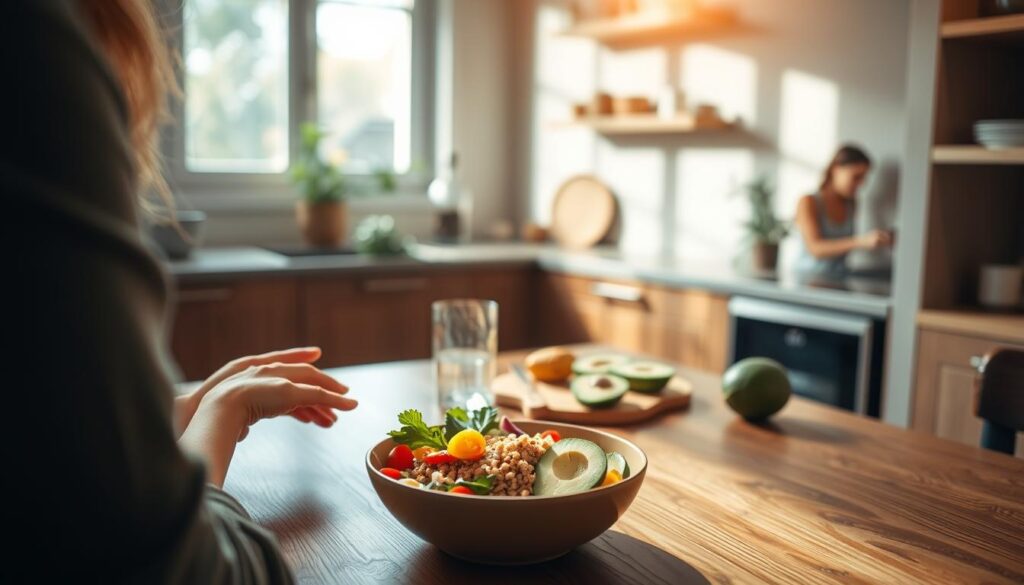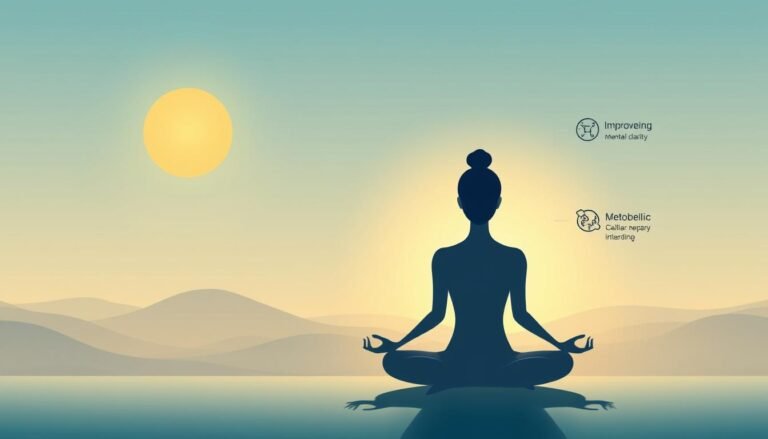Did you know 95% of traditional diets fail within a year? This fact shows why we need sustainable tips for a healthy lifestyle. Creating a healthy lifestyle without strict diets is not just possible—it’s the key to lasting change.
Learning to be healthy without dieting means moving from quick fixes to lasting changes. Building a healthy lifestyle naturally means seeing wellness as a journey, not a goal reached by restrictive eating.
Healthy habits without strict diets help people build a positive relationship with food, exercise, and well-being. This approach focuses on nourishing your body and listening to its needs. It helps create sustainable practices that support your health goals.
Key Takeaways
- Diets often fail because they’re unsustainable
- Wellness is about lifestyle, not temporary restrictions
- Holistic health involves mind, body, and emotional balance
- Sustainable changes create lasting results
- Personal well-being requires personalized strategies
Understanding the Difference Between Dieting and Sustainable Health
Creating a realistic wellness routine is more than just losing weight fast. Many people face challenges with diets that don’t last. The secret to staying fit without dieting is knowing the difference between strict diets and lasting lifestyle changes.

Traditional diets often lead to quick but short-lived results and frustration. Sustainable health aims for balance without dieting. It focuses on holistic methods that care for both body and mind.
Short-Term Diets vs. Long-Term Lifestyle Changes
- Short-Term Diets:
- Restrictive eating patterns
- Quick but unsustainable weight loss
- Potential nutrient deficiencies
- Long-Term Lifestyle Changes:
- Balanced nutrition
- Consistent healthy habits
- Holistic approach to wellness
The Psychology Behind Sustainable Health Habits
Building lasting health habits needs understanding of psychological triggers and motivation. Successful wellness journeys rely on intrinsic motivation, not just external pressures.
| Psychological Aspect | Impact on Health |
|---|---|
| Positive Self-Image | Increased motivation and consistency |
| Mindful Eating | Better relationship with food |
| Stress Management | Reduced emotional eating |
Breaking Free from Diet Culture
To break free from restrictive dieting, you need a mental change. Focus on nourishing your body, enjoying physical activity, and building a positive food relationship. True wellness is about feeling great, not just looking good.
“Health is not about the weight you lose, but the life you gain.” – Unknown
How to Create a Sustainable Healthy Lifestyle (Without Dieting)

Creating a sustainable healthy lifestyle is more than quick fixes and strict diets. It’s about adopting holistic methods that change your daily life. The goal is to make gradual, personal changes for better health.
To begin your journey to healthy living, consider these key strategies:
- Mindful Nutrition: Eat whole foods that give you real energy and satisfaction
- Enjoyable Movement: Pick physical activities you love, making exercise feel rewarding
- Mental Wellness: Focus on managing stress and emotional balance as key health aspects
- Self-Care Practices: Create routines that support your physical and mental health
The idea of avoiding diets for healthy living is about building lasting habits. This method helps you connect with your body’s needs and signals in a natural way.
“Health is not about perfection, but consistent, compassionate self-care.”
Changing to a healthier lifestyle doesn’t need big changes. Small, steady steps lead to lasting changes. By focusing on overall well-being, you’ll find a balanced, enjoyable way to live healthily.
Building a Foundation for Mindful Eating Habits
Getting healthy isn’t just about dieting. The no-diet way focuses on a good relationship with food. It’s about eating mindfully, not dieting.

Mindful eating means knowing what your body needs and eating with kindness. It changes how you see food, moving from strict rules to listening to your body.
Listening to Your Body’s Natural Hunger Cues
It’s important to know when you’re hungry. Here are some tips for listening to your body:
- Stop before eating and check if you’re really hungry
- Eat slowly and notice when you feel full
- Know the difference between hunger and eating because you’re upset
- Keep a food diary to see your eating patterns
Creating a Balanced Plate Without Restrictions
Eating well doesn’t mean cutting out foods or following strict rules. It’s about variety and nourishment.
- Have a mix of proteins, carbs, and fats
- Choose foods that are whole and not processed
- Be aware of your portions without being too strict
- Enjoy treats sometimes without feeling guilty
Developing a Healthy Relationship with Food
Eating should be enjoyable, not scary. It’s about emotional awareness and being kind to yourself. Food is a source of joy and connection.
“Eating is a natural, pleasurable activity that should be enjoyed, not feared.”
By following these ideas, you can find a healthy way to eat that supports your well-being.
Incorporating Physical Activity That You Actually Enjoy
Finding happiness and health isn’t about hard workouts or strict plans. It’s about finding fun physical activities that make you feel good. Living healthy means finding movements that match your interests and energy.
The secret to lasting fitness is loving wellness, not just losing weight. Physical activity should celebrate what your body can do, not punish it for what you eat.
- Dance classes that make you smile
- Hiking trails with beautiful scenery
- Recreational sports with friends
- Yoga or stretching sessions
- Cycling through neighborhood paths
Starting healthy habits is easy when you find activities you love. Try different things until you find something fun, not just exercise. Some like group classes, while others prefer solo activities like swimming or rock climbing.
Movement is a gift, not a chore. Choose activities that make your body and soul feel alive.
Remember, it’s better to be consistent than intense. Begin with short, easy sessions and slowly increase your time. The aim is to build a lasting, enjoyable relationship with physical activity that boosts your health.
Establishing Realistic Wellness Routines
Starting a non-diet health journey means creating lasting wellness habits. These habits should feel good and not feel like a chore. They should support your overall health.
Creating a healthy lifestyle is more than just counting calories. It’s about making choices that improve your health in a holistic way. This approach makes you feel good without focusing on calorie counting.
Designing Powerful Morning Habits
Good wellness routines begin with morning habits that set a positive tone:
- Drink water as soon as you wake up
- Do 10 minutes of gentle stretching
- Write down three things you’re grateful for
- Have a nutritious breakfast
Evening Rituals for Comprehensive Health
Evening routines help you relax and get ready for a good night’s sleep:
- Stop using screens an hour before bed
- Try relaxation techniques
- Get your clothes and meals ready for tomorrow
- Think about what you’ve accomplished today
Strategic Weekly Planning
Planning each week helps make wellness a part of your life. Spend time each week to:
- Look back at what you’ve done
- Set achievable goals
- Plan self-care activities
- Prepare healthy meals
Remember, true health is about making progress, not being perfect. Be flexible and kind to yourself on your wellness journey.
Stress Management and Mental Well-being
Creating a healthy lifestyle is more than just what we eat. Our mental health is key to staying well. Too much stress can mess with our habits and eating.
Managing stress needs a full-body approach. Knowing how our mind affects our body helps us build stronger habits.
- Practice daily mindfulness meditation
- Establish consistent sleep routines
- Implement time management techniques
- Develop emotional regulation skills
Mindfulness offers great ways to cut down stress. Breathing exercises and short meditations can really help. They lower stress hormones and boost our health.
| Stress Management Technique | Daily Time Investment | Potential Benefits |
|---|---|---|
| Meditation | 10-15 minutes | Reduced anxiety, improved focus |
| Journaling | 5-10 minutes | Emotional processing, stress relief |
| Physical Exercise | 30 minutes | Endorphin release, mood enhancement |
Building a healthy lifestyle means adding mental wellness to our daily life. Small, regular steps can change how we handle stress and feel overall.
“Mental health is not a destination, but a process. It’s about how you drive, not where you’re going.” – Noam Shpancer, PhD
Wellness is personal. What works for one might not for another. Try different ways to find what works best for you.
Creating a Supportive Environment for Healthy Living
Wellness is more than just personal habits. Your surroundings and the people around you matter a lot. They can help or hinder your efforts to eat mindfully, exercise regularly, and feel well overall.
Organizing Your Space for Success
Start by designing your space for health. Here are some tips to help:
- Clear kitchen counters of processed foods
- Create a dedicated workout area at home
- Stock visible, healthy snack options
- Arrange living spaces to encourage movement
Building a Support Network
A strong support system makes managing stress easier. Here’s how to build meaningful connections:
- Join fitness classes or wellness groups
- Share health goals with trusted friends
- Connect with like-minded individuals online
- Seek accountability partners
Managing Social Pressures
It’s tough to stay healthy in social situations. Here are some tips to help:
| Social Scenario | Wellness Strategy |
|---|---|
| Restaurant Dining | Choose healthier menu options |
| Social Gatherings | Bring a nutritious dish to share |
| Peer Pressure | Practice confident, kind refusals |
Creating a supportive environment means making choices that support your wellness. Small, consistent changes can make a big difference in your health over time.
Sustainable Nutrition Without Counting Calories
Changing your lifestyle doesn’t mean counting every calorie. Intuitive eating is a great way to eat. It’s about listening to your body and enjoying food without strict diets.
Wellness is more than just numbers. It’s about nourishing your body with good food. This way, you make lasting changes that feel good.
- Focus on whole, nutrient-dense foods
- Pay attention to hunger and fullness cues
- Enjoy meals without guilt
- Practice mindful eating
“Nutrition is not about perfection, but about making consistent, compassionate choices for your body.”
Here are some tips for good nutrition:
- Recognize true hunger versus emotional eating
- Create balanced meals with diverse nutrients
- Listen to your body’s unique needs
- Enjoy food as a source of nourishment and pleasure
By following these tips, you’ll have a better relationship with food. Changes happen slowly. Nutrition is about making habits that feel natural and rewarding.
Developing Self-Care Practices That Stick
Self-care is key to a full wellness journey, more than just eating right and exercising. It’s about taking care of both your body and mind. By making self-care a habit, you can improve your health for good.
Physical Self-Care Routines
Creating physical self-care routines means doing things that help your body. These can be:
- Regular sleep schedules
- Hydration tracking
- Stretching and mobility exercises
- Daily skincare rituals
- Regular medical check-ups
Emotional Well-being Practices
Emotional self-care is just as vital for your well-being. Important steps include:
- Practicing daily meditation
- Journaling emotional experiences
- Engaging in therapy or counseling
- Practicing mindfulness techniques
Setting Boundaries for Better Health
Setting clear boundaries helps protect your mental and physical health. It prevents burnout and supports lasting self-care.
| Boundary Type | Purpose | Implementation Strategy |
|---|---|---|
| Work Boundaries | Prevent Professional Overload | Set clear working hours |
| Social Boundaries | Manage Emotional Energy | Learn to say no respectfully |
| Personal Time | Ensure Self-Restoration | Schedule dedicated personal time |
By adding these self-care habits to your daily life, you take a holistic approach to wellness. This supports long-term health and personal growth.
Measuring Progress Without the Scale
Tracking your wellness journey is more than just looking at numbers on a scale. A healthy mindset sees many signs of growth and improvement. By focusing on overall wellness, you can see the full range of positive changes in your life.
Progress can be shown in many ways that go beyond just weight:
- Increased energy levels throughout the day
- Improved sleep quality and duration
- Enhanced strength and flexibility
- Better mood and mental clarity
- Reduced stress and improved emotional resilience
Exercise becomes more fun when you celebrate your personal wins, not just weight loss. Track what matters most to your wellness journey:
| Tracking Method | Benefits |
|---|---|
| Performance Measurements | Tracking workout improvements, endurance, and strength gains |
| Body Composition | Monitoring muscle mass and body fat percentage |
| Energy and Mood Journaling | Recording daily well-being and emotional states |
Pro tip: Take progress photos, note how clothing fits, and pay attention to your overall sense of vitality. These indicators provide a holistic view of your health transformation.
“Success is not about a number, but about feeling strong, confident, and truly alive in your body.”
Navigating Challenges and Setbacks
Building a sustainable healthy lifestyle isn’t about being perfect. It’s about being resilient and knowing that setbacks happen. When you focus on healthy habits without strict diets, you’ll face obstacles that test your dedication.
Setbacks are normal when you’re trying to live a healthy lifestyle naturally. The important thing is to find ways to overcome these challenges:
- Recognize negative self-talk and replace it with compassionate thoughts
- Identify specific triggers that derail your sustainable healthy lifestyle tips
- Create backup plans for moments of low motivation
- Practice flexible problem-solving instead of rigid expectations
When motivation drops, remember that being healthy without dieting means understanding yourself. Track your progress by how you feel and your energy levels, not just by strict numbers.
“Progress isn’t linear, it’s a journey of continuous learning and adaptation.”
Here are some practical tips to stay on track:
- Schedule weekly check-ins with yourself
- Create a supportive environment
- Celebrate small victories
- Be patient with your personal growth
Your wellness journey is unique. Be flexible, learn from challenges, and keep committing to your health goals.
Conclusion
Creating a healthy lifestyle is more than quick fixes. It’s about a lasting approach to wellness. This journey is personal and takes patience, kindness, and understanding your body’s needs.
A good wellness routine isn’t about being perfect. It’s about making consistent, meaningful choices. By focusing on mindful eating, fun physical activities, and self-care, you can find balance without dieting. The strategies shared here show that true health comes from caring for your body and mind.
Sustainable wellness is a lifelong journey that grows with you. It’s about listening to your body, managing stress, and building supportive environments. It’s about developing habits that improve your life quality. Remember, health is a journey, not a destination.
As you continue on your wellness path, remember it’s unique to you. Every small step and mindful choice brings you closer to a healthier you. The most powerful change comes from caring for yourself with compassion, curiosity, and a desire to thrive.





